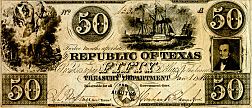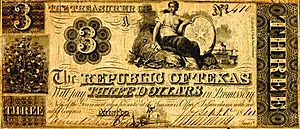Texas dollar facts for kids
Quick facts for kids Texas dollar |
|||
|---|---|---|---|
|
|||
| User(s) | |||
| Banknotes | $1, $2, $3, $5, $10, $20, $50, $100, $500 | ||
| This infobox shows the latest status before this currency was rendered obsolete. | |||
The Texas dollar was the money used in the Republic of Texas. This was a country that existed before Texas joined the United States. Different types of money were made, but the government had trouble making it valuable. This was because of money problems happening at the time. The Republic of Texas used gold and silver coins from the United States. However, it never made its own coins.
Contents
What Were Redbacks?
"Redbacks" were special paper money notes. The government of the Republic of Texas printed them between January 1839 and September 1840. President Mirabeau B. Lamar had them made to help pay off the country's debts.
Why Did Redbacks Lose Value?
The government printed too many redbacks. This caused something called inflation. Inflation means that money loses its value. For example, 15 redbacks became worth only one United States dollar. This huge debt, over $10 million, was a big reason why Texas later joined the United States. This joining is called annexation.
What Did Redbacks Look Like?
Redbacks came in different amounts, like $5, $10, $20, $50, $100, and $500 bills. There were also smaller "change notes" for $1, $2, and $3. These smaller notes had a blank back. All these notes were printed in Austin. Many of the notes look orange today because of the ink used. Some people think this orange color inspired the "burnt orange" color of The University of Texas at Austin. However, there is no proof of this.
Collecting Redbacks Today
When the government got redbacks back, they would "cut-cancel" them. This meant cutting a piece out of them. This stopped people from using them again by mistake. Collectors of old money, called numismatists, really like these cut-cancelled notes. Some notes were never returned or cut. These are worth even more money to collectors.
Two important heroes from the early Republic of Texas are on redbacks. Both of them had died before the notes were printed. Deaf Smith is on the $5 redback. Stephen F. Austin, often called the "Father of Texas," is on the $50 note.
By 1842, the Texas government knew redbacks had lost their value. They stopped accepting them for taxes at their original worth. Texans started using money from the United States more often. They also used other types of private money.
Exchequer Bills: A New Try
When redbacks stopped being used, John Tyler was the president in the United States. He had an idea for a new paper money system. When Sam Houston became president of Texas again, he tried a similar idea. He called the new money "exchequer bills."
Success of Exchequer Bills
At first, these new bills did not work very well. But the next year, money problems in North America started to get better. By 1845, the exchequer bills were worth their full value. This means they were "passing at par value."
Later, in 1850, a deal called the Compromise of 1850 was made. Texas received $10 million for giving up some land claims. With this money, Texas was able to pay off all its old debts. This included buying back its exchequer bills.



